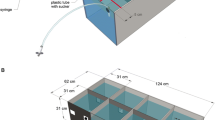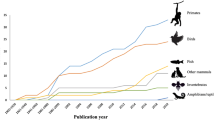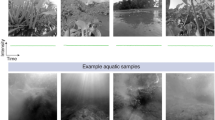Abstract
Video playback has become an important tool for testing certain questions about animal visual perception. While a few studies have compared the response of test subjects to live and video stimuli, it is generally assumed a priori that the animals will respond to the video image as if it were ‘real’. Since video devices are tuned to the spectral sensitivities and flicker fusion frequencies of the human eye and brain, it is important to conduct preliminary tests to compare the response of test subjects between live and video images. Here we compare schooling behavior of tiger barbs, Puntius tetrazona, when presented with a school of live fish, an analog video school of fish and a video of a computer-animated school of fish. Test subjects did not show a significantly different schooling behavior response to any of these stimuli. Additionally, when given the choice of schooling with a conspecific versus a heterospecific, tiger barbs schooled significantly more often with the conspecifics for all three stimulus formats. This study provides evidence that tiger barbs do not choose to discriminate between live and video models of fish and that this technique can be used to test future questions concerning visual perception for this species.
Similar content being viewed by others
References cited
Altbacher, B. & V. Csanyi. 1990. The role of eyespots in predator recognition and antipredator behaviour in the paradise fish, Macropodus opercularis L. Ethology 85: 51–57.
Baerends, G.P. 1976. The significance of colour patterns in fish for the study of some fundamental issues in behaviour. Rev. Trav. Inst. Pêches marit. 40: 413–423.
Baerends, G.P. & J.M. Baerends-van Roon. 1950. An introduction to the study of cichlid fishes. Behaviour (Supp.) 1: 1–242.
Baker, M.C., T.T. Tracy & L.E. Miyasato. 1996. Gargle vocalizations of black-capped chickadees: test of repertoire and video stimuli. Anim. Behav. 52: 1171–1175.
Barlow, G.W., W. Rogers & A.B. Bond. 1984. Dummy-elicited aggressive behavior in the polychromatic midas cichlid. Biology of Behavior 9: 115–130.
Barlow, G.W. & P. Siri. 1997. Does sexual selection account for the conspicuous head dimorphism in the Midas cichlid? Anim. Behav. 53: 573–584.
Basolo, A.L. 1990. Female preference predates the evolution of sword in swordtail fish. Science 250: 808–810.
Bolyard, K.J. & W.J. Rowland. 1996. Context-dependent response to red coloration in stickleback. Anim. Behav. 52: 923–927.
Brown, J.L. 1965. Flicker and intermittent stimulation. pp. 251–320. In: C.H. Graham (ed.) Vision and Visual Perception, John Wiley, New York.
Clark, D.L. & G.W. Uetz. 1990. Video image recognition by the jumping spider, Maevia inclemens (Araneae: Salticidae). Anim. Behav. 40: 884–890.
Clark, D.L. & G.W. Uetz. 1992. Morph-independent mate selection in a dimorphic jumping spider: demonstration of movement bias in female choice using video-controlled courtship behaviour. Anim. Behav. 43: 247–254.
Clark, D.L. & G.W. Uetz. 1993. Signal efficacy and the evolution of male dimorphism in the jumping spider, Maevia inclemens. Proc. Nat. Acad. Sci. USA 90: 11954–11957.
Clark, D.L., J.M. Macedonia & G.G. Rosenthal. 1997. Testing video playback to lizards in the field. Copeia 1997: 421–423.
D'eath, R.B. & M.S. Dawkins. 1996. Laying hens do not discriminate between video images of conspecifics. Anim. Behav. 52: 903–912.
Douglas, R.H. & C.W. Hawryshyn. 1990. Behavioural studies of fish vision: an analysis of visual capabilities. pp. 373–418. In: R.H. Douglas & M.B.A. Djamgoz (ed.) The Visual System of Fish, Chapman and Hall, London.
Dreyfert, T., K. Holmberg & G. Struwe. 1979. Critical flicker fusion frequency of the river lamprey. Vision Research 19: 551–553.
Evans, C.S. & P. Marler. 1991. On the use of video images as social stimuli in birds: audience effects on alarm calling. Anim. Behav. 41: 17–26.
Evans, C.S., L. Evans & P. Marler. 1993a. On the meaning of alarm calls: functional reference in an avian vocal system. Anim. Behav. 46: 23–38.
Evans, C.S., J.M. Macedonia & P. Marler. 1993b. Effects of apparent size and speed on the response of chickens, Gallus gallus, to computer generated simulations of aerial predators. Anim. Behav. 46: 1–11.
Figler, M.H. 1972. The relation between eliciting stimulus strength and habituation of the threat display in male Siamese fighting fish, Betta splendens. Behaviour 42: 63–96.
Gallup, G.G., Jr. 1970. Chimpanzees: self-recognition. Science 167: 86–87.
Guthrie, D.M. & W.R.A. Muntz. 1993. Role of vision in fish behaviour. pp. 89–128. In: T.J. Pitcher (ed.) Behaviour of Teleost Fishes, 2nd ed., Chapman and Hall, London.
Hay, T.F. 1978. Filial imprinting in the convict cichlid fish Cichlasoma nigrofascinatum. Behaviour 65: 138–160.
Heiligenberg, W., U. Kramer & V. Schultz. 1972. The angular orientation of the black eyebar in Haplochromis burtoni and its relevance to aggressivity. Z. vergl. Physiol. 76: 168–176.
Hurley, A.C. & P.H. Hartline. 1974. Escape response in the damselfish Chromis cyanea (Pisces: Pomacentridae): a quantitative study. Anim. Behav. 22: 430–437.
Jenssen, T.A. 1970. Female response to filmed displays of Anolis nebulosus (Sauria, Iguanidae). Anim. Behav. 18: 640–647.
Karplus, I., M. Goren & D. Algom. 1982. A preliminary experimental analysis of predator face recognition by Chromis caerulaeus. Z. Tierpsychol. 61: 149–156.
Kodric-Brown, A. & P.F. Nicoletto. 1997. Repeatability of female choice in the guppy: response to live and videotaped males. Anim. Behav. 54: 369–376.
Landis, C. 1954. Determinants of critical flicker-fusion threshold. Physiol. Rev. 34: 259–286.
Levinson, J.Z. 1968. Flicker fusion phenomena. Science 160: 21–28.
Macedonia, J.M., C.S. Evans & J.B. Losos. 1994. Male Anolis lizards discriminate video-recorded conspecifics and heterospecific displays. Anim. Behav. 47: 1220–1223.
Macedonia, J.M. & J.A. Stamps. 1994. Species recognition in Anolis grahami: evidence from responses to video playbacks of conspecific and heterospecific displaying. Ethology 98: 246–264.
McClintock, W.J. & G.W. Uetz. 1996. Female choice and pre-existing bias: visual cues during courtship in two Schizocosa wolf spiders (Araneae; Lycosidae). Anim. Behav. 53: 167–181.
McDonald, C.G., T.E. Reimchen & C.W. Hawryshyn. 1995. Nuptial colour loss and signal masking in Gasterosteus: an analysis using video imaging. Behaviour 132: 963–978.
McKinnon, J.S. 1995. Video mate preferences of female three-spined sticklebacks from populations with divergent male coloration. Anim. Behav. 50: 1645–1655.
McKinnon, J.S. & J.D. McPhail. 1996. Male aggression and colour in divergent populations of the threespine stickleback: experiments with animations. Can. J. Zool. 74: 1727–1733.
McQuoid, L.M. & B.G. Galef, Jr. 1993. Social stimuli influencing feeding behaviour of Burmese fowl: a video analysis. Anim. Behav. 46: 13–22.
McQuoid, L.M. & B.G. Galef, Jr. 1994. Effects of access to food during training on social learning by Burmese red junglefowl. Anim. Behav. 48: 737–739.
Pietrewicz, A.T. & A.C. Kamil. 1981. Search images and the detection of cryptic prey: an operant approach. pp. 311–332. In: A.C. Kamil & T.D. Sargent (ed.) Foraging Behavior: Ecological, Ethological and Psychological Approaches, Garland STPM Press, New York.
Rhoad, K.D., J.W. Kalat & P.H. Klopfer. 1975. Aggression and avoidance by Betta splendens toward natural and artificial stimuli. Anim. Learn. Behav. 3: 271–276.
Rosenthal, G.G., C.S. Evans & W.L. Miller. 1996. Female preference for dynamic traits in the green swordtail, Xiphophorus helleri. Anim. Behav. 51: 811–820.
Roster, N.O., D.L. Clark & J.C. Gillingham. 1995. Prey catching behavior in frogs and toads using video-simulated prey. Copeia 1995: 496–498.
Rowland, W.J. 1975. System interaction of dummy-elicited behavior in the jewel cichlid, Hemichromis bimaculatus Gill. Behaviour 53: 171–182.
Rowland, W.J. 1995. Do female sticklebacks care about male courtship vigor? Manipulation of display tempo using video playback. Behaviour 132: 951–961.
Rowland, W.J. 1999. Studying visual cues in fish behavior: a review of ethological techniques. Env. Biol. Fish. 56: 287–307 (this issue).
Rowland, W.J., K.J. Bolyard, J.J. Jenkins & J. Fowler. 1995a. Video playback experiments on stickleback mate choice: female motivation and attentiveness to colour cues. Anim. Behav. 49: 1559–1567.
Rowland, W.J., K.J. Bolyard & A.D. Halpern. 1995b. The dual effect of stickleback nuptial coloration on rivals: manipulation of a graded signal using video playback. Anim. Behav. 50: 267–272.
Schwassmann, H.O. & L. Kruger. 1968. Anatomy of visual centers in teleosts. pp. 3–16. In: D. Ingle (ed.) The Central Nervous System and Fish Behavior, University of Chicago Press, Chicago.
Stacey, P.B. & D. Chiszar. 1978. Body colour pattern and aggressive behaviour of male pumpkinseed sunfish (Lepomis gibbosus). Behaviour 64: 271–304.
ter Pelkwijk, J.J. & N. Tinbergen. 1937. Eine Reizbiologische Analyse einiger Verhaltensweisen von Gasterosteus aculeatus L.Z. Tierpsychol. 1: 193–200.
Tinbergen, N. 1948. Social releasers and the experimental method for their study. Wilson Bull. 60: 6–51.
Tinbergen, N. 1952. The curious behavior of the stickleback. Sci. Amer. 187(6): 22–26.
Tomita, T. 1971. Vision: electrophysiology of the retina. pp. 33–57. In: W.S. Hoar & D.J. Randall (ed.) Fish Physiology, Volume 6, Academic Press, New York.
Uetz, G.W., W.J. McClintock, D. Miller, E.I. Smith & K.K. Cook. 1996. Limb regeneration and subsequent asymmetry in a male secondary sexual character influences sexual selection in wolf spider. Behav. Ecol. Sociobiol. 38: 253–257.
Author information
Authors and Affiliations
Rights and permissions
About this article
Cite this article
Clark, D.L., Stephenson, K.R. Response to Video and Computer-animated Images by the Tiger Barb, Puntius tetrazona. Environmental Biology of Fishes 56, 317–324 (1999). https://doi.org/10.1023/A:1007549721631
Issue Date:
DOI: https://doi.org/10.1023/A:1007549721631




